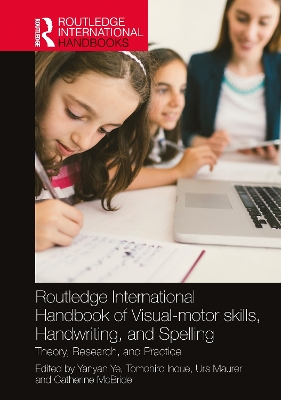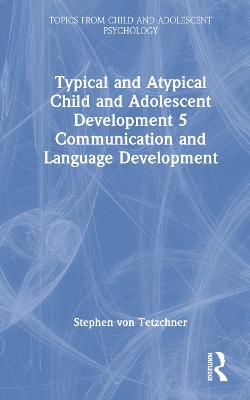Routledge International Handbook of Visual-motor skills, Handwriting, and Spelling
 portes grátis
portes grátis
Routledge International Handbook of Visual-motor skills, Handwriting, and Spelling
Theory, Research, and Practice
McBride, Catherine; Ye, Yanyan; Inoue, Tomohiro; Maurer, Urs
Taylor & Francis Ltd
11/2024
476
Mole
Inglês
9781032255767
Pré-lançamento - envio 15 a 20 dias após a sua edição
Yanyan Ye, Tomohiro Inoue, Urs Maurer, and Catherine McBride
Section I: The fundamentals of handwriting skills and literacy acquisition
Chapter 1: Visual-Motor Skill and General Cognitive Ability
Sebastian Paul Suggate
Chapter 2: Chinese character handwriting: Lexical effects, individual differences, character amnesia, and developmental dysgraphia
Zebo Xu and Zhenguang G. Cai
Chapter 3: Visual motor integration and writing development: A systematic review
of empirical research in Chinese
Rui Dong and Li Yin\
Chapter 4: It's About the Process, Not Perfection: What Spelling Fluency Tells Us About Spelling
Emily Cote, Helen L. Breadmore, and S. Helene Deacon
Chapter 5: Handwriting and Motor Skill Learning
Rafat Ghanamah, Mona S. Julius, and Esther Adi-Japha
Chapter 6: Conceptualizing and operationalizing Chinese early writing skills: Integrate cognitive and sociocultural perspectives
Chenyi Zhang, Xiao Zhang, Gary E. Bingham
Section II: Cognitive and neural mechanisms of handwriting skills and literacy acquisition
Chapter 7: The contribution of handwriting to letter processing in early reading development: evidence from behavioral and neuroimaging research
Sophia Vinci-Booher and Karin H. James
Chapter 8: How handwriting shapes literacy acquisition and general cognition: Phenomena and cognitive mechanisms
Markus Kiefer and Manfred Spitzer
Chapter 9: Does orthographic working memory matter in Chinese spelling?
Jianhong Mo
Chapter 10: Intrinsic and Extrinsic Factors of Handwriting and Their Impacts on Reading: A View from Embodied Cognition
Zhengye Xu and Duo Liu
Section III: Theories and methods in spelling development
Chapter 11: Three Facets of Spelling
Jayde E. Homer, Molly Farry-Thorn, and Rebecca Treiman
Chapter 12: Understanding Types of Chinese Writing-to-Dictation Errors
Bing Han, Trelani F. Milburn, Poh Wee Koh, and R. Malatesha Joshi
Chapter 13: Credibly Assessing Writing Transcription Skills: Application of Generalizability Theory
Steve Graham, Alan Huebner, and Gustaf B. Skar,
Chapter 14: The Role of Children's Learning about Print in the Development of Reading and Spelling Skills
Savannah Heintzman, S. Helene Deacon, and Nicole J. Conrad
Chapter 15: Invented Spelling: Perspectives on Assessment and Intervention
Yi Ding and Yangqian Shen
Chapter 16: The Role Played by Spelling in Reading Acquisition and Instruction: Starring, Supporting, or Just a Bit Part?
Gene Ouellette
Chapter 17: Conceptual Understanding, Assessment, and Instruction for Word Spelling in English, a Morphophonemic Orthography
Virginia Wise Berninger
Chapter 18: Creating a Team Approach to Handwriting Instruction: How Collaboration Between the School-Based Occupational Therapist and Primary Teacher Can Facilitate Literacy Development
Kathleen S. Wright and Carol H. Armann
Section IV: Global literacy and spelling
Chapter 19: Spelling in Some Alphabetic Languages
Alida Hudson, Karol A. Moore, Juan Quinonez-Beltran, Jialin Lai, and R. M. Joshi
Chapter 20: Spelling Arabic: When does Orthographic Knowledge End and Language Knowledge Start?
Elinor Saiegh-Haddad,Ola Ghawi-Dakwar, Lina Haj, Ranya Farraj-Bsharat, and Lior Laks
Chapter 21: Early invented spelling predicts later word-reading ability beyond early phoneme awareness and word-reading ability: Evidence from Brazilian Portuguese
Claudia Cardoso-Martins, Tatiana Pollo, Alana Helena Paulino dos Santos, and Carolyn B. Mervis
Chapter 22: Spelling and Writing Development in Thai
Heather Winskel
Chapter 23: Immediate and Delayed Copying of Familiar and Unfamiliar Scripts
in Spelling among Korean Kindergartners
Jeung-Ryeul Cho
Chapter 24: Emergent biliteracy: Spelling development across writing systems and scripts
Beth Ann O'Brien and Malikka Begum Habib Mohamed
Section V: Home learning environment and spelling
Chapter 25: Parents' beliefs regarding their children's early literacy surrounding a writing interaction and their relations to children's early literacy skills
Dorit Aram and Deborah Bergman Deitcher
Chapter 26: Children's early spelling development in the context of the home literacy environment
Frank Niklas, Astrid Wirth, Anna Mues, and Efsun Birtwistle
Section VI: Dysgraphia, Handwriting difficulties, and Dyslexia
Chapter 27: Handwriting Difficulties in Developmental Dyslexia
Marie Van Reybroeck and Claire Gosse
Chapter 28: Taking the mask off dysgraphia
Cheri Dotterer
Chapter 29: Handwriting Analytics
Burget, L., Wang C., Asselborn, T., Tozadore, D., Johal, W., Gargot, T., Sandygulova, A.,
Kidzinski, L., D, Cohen, D., and Dillenbourg, P.
Section VII: Spelling and writing in the digital age
Chapter 30: Chinese spelling - evidence from pen tablets
Dustin Kai-Yan Lau
Chapter 31: Digital communication, texting, and literacy acquisition
Nenagh Kemp
Yanyan Ye, Tomohiro Inoue, Urs Maurer, and Catherine McBride
Section I: The fundamentals of handwriting skills and literacy acquisition
Chapter 1: Visual-Motor Skill and General Cognitive Ability
Sebastian Paul Suggate
Chapter 2: Chinese character handwriting: Lexical effects, individual differences, character amnesia, and developmental dysgraphia
Zebo Xu and Zhenguang G. Cai
Chapter 3: Visual motor integration and writing development: A systematic review
of empirical research in Chinese
Rui Dong and Li Yin\
Chapter 4: It's About the Process, Not Perfection: What Spelling Fluency Tells Us About Spelling
Emily Cote, Helen L. Breadmore, and S. Helene Deacon
Chapter 5: Handwriting and Motor Skill Learning
Rafat Ghanamah, Mona S. Julius, and Esther Adi-Japha
Chapter 6: Conceptualizing and operationalizing Chinese early writing skills: Integrate cognitive and sociocultural perspectives
Chenyi Zhang, Xiao Zhang, Gary E. Bingham
Section II: Cognitive and neural mechanisms of handwriting skills and literacy acquisition
Chapter 7: The contribution of handwriting to letter processing in early reading development: evidence from behavioral and neuroimaging research
Sophia Vinci-Booher and Karin H. James
Chapter 8: How handwriting shapes literacy acquisition and general cognition: Phenomena and cognitive mechanisms
Markus Kiefer and Manfred Spitzer
Chapter 9: Does orthographic working memory matter in Chinese spelling?
Jianhong Mo
Chapter 10: Intrinsic and Extrinsic Factors of Handwriting and Their Impacts on Reading: A View from Embodied Cognition
Zhengye Xu and Duo Liu
Section III: Theories and methods in spelling development
Chapter 11: Three Facets of Spelling
Jayde E. Homer, Molly Farry-Thorn, and Rebecca Treiman
Chapter 12: Understanding Types of Chinese Writing-to-Dictation Errors
Bing Han, Trelani F. Milburn, Poh Wee Koh, and R. Malatesha Joshi
Chapter 13: Credibly Assessing Writing Transcription Skills: Application of Generalizability Theory
Steve Graham, Alan Huebner, and Gustaf B. Skar,
Chapter 14: The Role of Children's Learning about Print in the Development of Reading and Spelling Skills
Savannah Heintzman, S. Helene Deacon, and Nicole J. Conrad
Chapter 15: Invented Spelling: Perspectives on Assessment and Intervention
Yi Ding and Yangqian Shen
Chapter 16: The Role Played by Spelling in Reading Acquisition and Instruction: Starring, Supporting, or Just a Bit Part?
Gene Ouellette
Chapter 17: Conceptual Understanding, Assessment, and Instruction for Word Spelling in English, a Morphophonemic Orthography
Virginia Wise Berninger
Chapter 18: Creating a Team Approach to Handwriting Instruction: How Collaboration Between the School-Based Occupational Therapist and Primary Teacher Can Facilitate Literacy Development
Kathleen S. Wright and Carol H. Armann
Section IV: Global literacy and spelling
Chapter 19: Spelling in Some Alphabetic Languages
Alida Hudson, Karol A. Moore, Juan Quinonez-Beltran, Jialin Lai, and R. M. Joshi
Chapter 20: Spelling Arabic: When does Orthographic Knowledge End and Language Knowledge Start?
Elinor Saiegh-Haddad,Ola Ghawi-Dakwar, Lina Haj, Ranya Farraj-Bsharat, and Lior Laks
Chapter 21: Early invented spelling predicts later word-reading ability beyond early phoneme awareness and word-reading ability: Evidence from Brazilian Portuguese
Claudia Cardoso-Martins, Tatiana Pollo, Alana Helena Paulino dos Santos, and Carolyn B. Mervis
Chapter 22: Spelling and Writing Development in Thai
Heather Winskel
Chapter 23: Immediate and Delayed Copying of Familiar and Unfamiliar Scripts
in Spelling among Korean Kindergartners
Jeung-Ryeul Cho
Chapter 24: Emergent biliteracy: Spelling development across writing systems and scripts
Beth Ann O'Brien and Malikka Begum Habib Mohamed
Section V: Home learning environment and spelling
Chapter 25: Parents' beliefs regarding their children's early literacy surrounding a writing interaction and their relations to children's early literacy skills
Dorit Aram and Deborah Bergman Deitcher
Chapter 26: Children's early spelling development in the context of the home literacy environment
Frank Niklas, Astrid Wirth, Anna Mues, and Efsun Birtwistle
Section VI: Dysgraphia, Handwriting difficulties, and Dyslexia
Chapter 27: Handwriting Difficulties in Developmental Dyslexia
Marie Van Reybroeck and Claire Gosse
Chapter 28: Taking the mask off dysgraphia
Cheri Dotterer
Chapter 29: Handwriting Analytics
Burget, L., Wang C., Asselborn, T., Tozadore, D., Johal, W., Gargot, T., Sandygulova, A.,
Kidzinski, L., D, Cohen, D., and Dillenbourg, P.
Section VII: Spelling and writing in the digital age
Chapter 30: Chinese spelling - evidence from pen tablets
Dustin Kai-Yan Lau
Chapter 31: Digital communication, texting, and literacy acquisition
Nenagh Kemp







